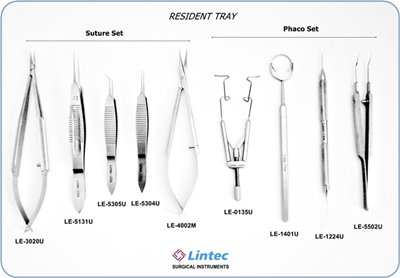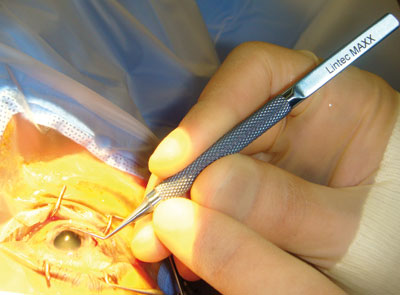OCULAR SURGERY NEWS U.S. EDITION May 25, 2009
For most routine anterior segment surgeries, a suture set and a phaco set are advisable.
During residency, teaching hospitals have multiple trays of surgical instruments for the physicians to share as they learn ocular surgery.
At the end of residency, most ophthalmologists will begin their practice or fellowship by purchasing their own surgical instrument sets. For our UCLA residents, I recommend purchasing two small sets initially: a suture set and a phaco set. These two sets are suitable for most routine anterior segment surgeries, and they are a good starting point for building a personalized toolbox of ocular instruments (Figure 1).
The basic suture set
Learning to suture with small gauge materials is a challenge for the beginning ophthalmologist, and there is no better way to improve sewing skills than to practice, particularly with your own instruments. You will need five basic instruments for your suture set, which will allow you to use anything from 10-0 nylon to 5-0 gut sutures.

Figure 1. A simplified resident tray of instruments is the foundation for building a complete toolbox for ocular surgery. This tray, composed of a suture set and a phaco set, has been designed for graduating residents by Lintec Surgical.
The needle driver must be fine enough to hold the tiny needles but sturdy enough for the larger ones. Options include a straight tip vs. a curved tip and locking vs. non-locking. To grasp tissue, toothed-forceps are available in different sizes and configurations. The smallest teeth, 0.12 mm, are suitable for fine tissue holding such as corneal suturing, whereas the larger teeth, 0.3 mm or 0.5 mm, may be better suited for more coarse work such as muscle or skin suturing.
Sutures can be tied using the tying platforms of the 0.12 mm forceps and the needle driver, but many surgeons prefer dedicated tying forceps for fine suturing detail. Two tying forceps, one straight and the other bent or curved, are recommended for a basic set. To cut and spread tissue, Wescott-type scissors are useful, particularly with a sharp tip. These scissors can also be used to cut suture material; however, this can lead to premature dulling of the blades, particularly when cutting large sutures.
Dissecting, cutting and suturing tissue can be done effectively with just these five instruments, but the most commonly performed surgery in ophthalmology is cataract surgery in the form of phacoemulsification.
The basic phaco set
A basic phaco set needs only a few instruments because much of what is used intraoperatively is disposable, such as blades and cannulae. A lid speculum with a low profile and an adjustment mechanism such as the Lieberman-style is helpful to keep the lids retracted and the lid margin and lashes away from the surgical field. A Fine-Thornton-style fixation ring can be used to securely hold the globe under topical anesthesia during incision creation and, in addition, clock hour markings (30 degree apart) can serve as a guide for both incision placement as well as limbal relaxing incisions for the correction of astigmatism.

Figure 2. Titanium instruments such as this capsulorrhexis forceps are lighter and more durable than steel, particularly after many sterilization cycles.
Capsulorrhexis forceps are a critical part of the phaco set because the creation of the anterior lens opening is one of the most critical parts of the cataract surgery. Fine-armed forceps with semi-sharp tips allow puncturing of the central capsule without the need for a cystotome. Curved tips can follow the natural intraocular anatomy and will avoid capturing iris tissue.
A simple manipulator such as the Nagahara-style chopper is useful for mechanically splitting the lens nucleus as well as for lifting an incision, dialing in IOL haptics and handling intraocular tissue. The opposite end of the chopper is a cyclodialysis spatula, which has a number of uses in anterior segment surgery.
Titanium is a light yet strong, non-magnetic metal that is resistant to corrosion. A light blue hue is added to titanium instruments to differentiate them from stainless steel. The matte finish is designed to be anti-reflective so that the microscope light does not bounce off the instruments and into the surgeonís eyes. Stainless steel instruments are also durable and tend to be more affordable than titanium instruments.
When purchasing instruments be sure to understand the service and guarantee because ophthalmic instruments need upkeep and periodic service. Most companies offer free trials of the instruments so that you can be sure to purchase exactly what you want. Assembling your toolbox of surgical instruments is an individualized process that takes years, but it is worth the investment because it makes performing surgery a pleasure.



